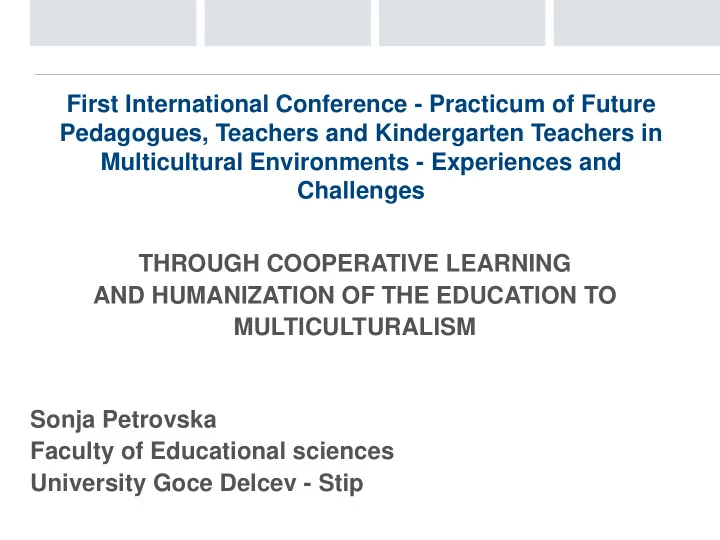

First International Conference - Practicum of Future Pedagogues, Teachers and Kindergarten Teachers in Multicultural Environments - Experiences and Challenges THROUGH COOPERATIVE LEARNING AND HUMANIZATION OF THE EDUCATION TO MULTICULTURALISM Sonja Petrovska Faculty of Educational sciences University Goce Delcev - Stip
Cooperative learning versus humanistic educational approach What is cooperative learning? Cooperative learning takes into account the cognitive and affective aspects of learning, emphasizes the activity of students, promotes collaboration and support, and also provides an opportunity for making a balance between individual and collective feelings of success / failure. What is humanistic educational approach? Humanistic approach to educational work particularly emphasizes learning in groups, learning from one another and learning and acting for each other. Feelings and knowledge are equally important for the learning process. (Sonja Petrovska, Snezana S. Veselinovska, 2008)
Cooperative learning versus humanistic educational approach Schools as humanistic contexts • School education that carries the epithet humanistic must take care of the development of skills for intercultural dialogue and offer content that will be the basis for meeting the educational needs of students belonging to different cultures (What is it that equally intrigues our children and young people?) • Cultural differences and their roles in everyday life have a reflection on the behavior of students and teachers who bring their own cultural patterns to school. According to Giroux (1992) schools play a vital role in helping Childs and adolescents understand, through various representations and practices, the ways in which difference is constructed. (Robert E. Slavin, Robert Cooper,1999)
Five dimensional model of multicultural education (Banks, J. A, 2004, pp. 39-29) • Content integration, • Knowledge construction, • Equity pedagogy, • Prejudice reduction, and • Empowering school culture and social structure.
Four dimensional model of multicultural education (Bennett, C, 2003) • Movement for equality and equity by creating a curriculum that helps to develop a common history; • Knowledge and understanding of others; • Process that includes the way a person becomes multicultural; • Commitment in the fight against discrimination through the development of appropriate skills and attitudes. 5
Humanistic versus multiculturalism Thesis: Constant struggle between the development of personal autonomy and the social demands lies in the heart of the humanistic education, (WielVeugelers ’, 2007) • Task of the multicultural organizational model of education: to develop intercultural communication that involves approximate understanding of the minds of others, whether or not we agree with their way of thinking (Piršl, 2007). • That means - balancing between personal and cultural autonomy and social requirements. What this means? 6
Humanistic versus multiculturalism BUT? • Developing autonomy and humanity is not a natural process. • Developing autonomy and humanity is an interactive process between people under social and political power relationships. • Enhancing autonomy and humanity is part of social, cultural and political developments. • Like autonomy that cannot be separated from humanity, human development cannot be separated from social, cultural and political struggle for a world of social justice. (WielVeugelers, 2007)) 7
School, humanism and multiculturalism • If school is required to develop intercultural sensitivity in students, then it must be a space for meeting, intertwining, complementing, and even opposing different cultures. • Limited contacts among students from different backgrounds (cultures) stimulate the creation of stereotypes and racial tensions (Crain et al, 1982; Oakes & Wells, 1995), and negative stereotypes are commonly used to justify hostility and contempt for others. (Lilli & Rehm, 1990). • In school humanism can be implemented as a paradigm, as a philosophy, and as a methodical-didactic approach. However, the central premise of humanism is that people act intentionally and with value judgement, and education represents a personal act through which the potential of the individual is realized. 8
School, humanism and multiculturalism Three areas of educational work in which is manifested humanism 1. Humanistic curriculum providing contents (topics) directly related to students' lives. 2. Humanistic educational process anticipated in the curriculum that includes a focus on every student in the process of teaching. 3. Humanistic school that involves structuring of groups and restructuring of the entire schedule of school activities . HOW? 9
CONCLUSION • The realization of the principles of humanistic education across the curriculum, didactic-methodical approaches to teaching and in functioning of school organization seems necessary for the development of multiculturalism as a transitional stage of interculturality. • The power and scope of cooperative learning is strongly determined by the way of introduction into school work. • The application of cooperative learning techniques in an accidental unplanned manner and only as a form of social organization of students is ineffective. • Introduction of this approach should be treated as a continuous process through which, above all, cooperation will be incorporated as a value in the class collective. Of course, the basic prerequisite for the establishment of multicultural groups (ethnicity) is creating an educational system in which children and young people from different cultures will learn in a common space. 10
COOPERATIVE LEARNING, HUMANIZATION OF THE EDUCATION AND MULTICULTURALISM MEAN INCLUSIV EDUCATIONAL CONTEXT! 11
Recommend
More recommend